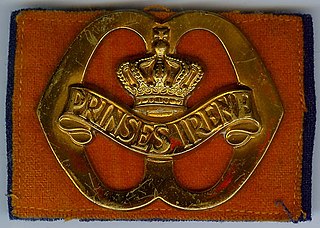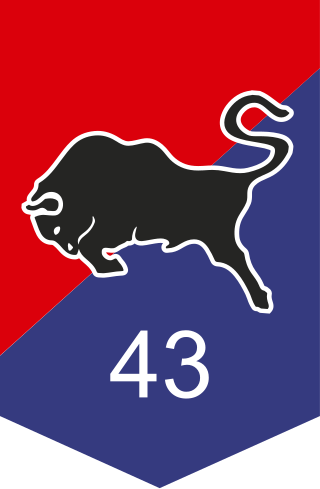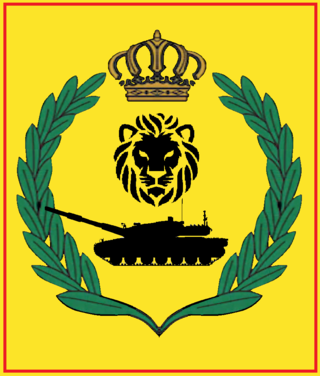
The 1st Cavalry Division is a combined arms division and is one of the most decorated combat divisions of the United States Army. It is based at Fort Cavazos, Texas. It was formed in 1921 and served during World War II, the Korean War, the Vietnam War, the Persian Gulf War, with the Stabilization Force in Bosnia and Herzegovina, the Iraq War, the War in Afghanistan as well as Operation Freedom's Sentinel and Operation Inherent Resolve. As of July 2023, the 1st Cavalry Division is subordinate to the III Armored Corps and is commanded by Major General Thomas M. Feltey.

The Princess Irene Fusiliers Guards Regiment is a regiment of the Royal Netherlands Army, named after Princess Irene, the Granddaughter of Queen Wilhelmina, daughter of Queen Juliana, sister of Princess Beatrix and aunt of King Willem-Alexander. It is one of two regiments, along with the Garderegiment Grenadiers en Jagers, to be classed as 'Guards'.

The Regiment Huzaren van Boreel is an armoured regiment of the Royal Netherlands Army, named for Willem Francois Boreel. It currently serves in the armoured Intelligence, Surveillance, Target Acquisition, Reconnaissance (ISTAR) role; the regiment provides armoured reconnaissance squadrons assigned to the 43 Mechanised Brigade, 13 Light Brigade and 11 Airmobile Brigade. An STA artillery unit, an electronic warfare unit, Human Intelligence (HUMINT) unit and imagery intelligence unit are all formed into a single battalion attached to the Combat Support Brigade.
The Regiment Huzaren Prins Alexander is an Armoured corps of the Royal Netherlands Army, named after Prince Alexander, the second son of King Willem II. This regiment represented the former 3rd Hussars Regiment, formed in 1814. It was known as the Red or Guards Hussars, but was never a Guards regiment.

The Regiment Huzaren van Sytzama was a Dutch armored regiment named for J.G. Baron van Sytzama, which was disbanded in 2012. Its origins may be traced to the French 14th Regiment of Cuirassiers which had in turn been formed from the Dutch 2nd Regiment of Cuirassiers in 1810. From these men, the Baron raised the regiment, later styled 1e Regiment Huzaren.

The Land Component, historically and commonly still referred to as the Belgian Army, is the land branch of the Belgian Armed Forces. The King of the Belgians is the commander in chief. The current chief of staff of the Land Component is Major-General Jean-Pol Baugnée.

The AIFV is a US tracked light armored vehicle that serves as an infantry fighting vehicle (IFV) in the armies of several countries. It is a development of the M113A1 armored personnel carrier.

The YPR-765 is a Dutch infantry fighting vehicle. It is based on the AIFV design developed by the FMC Corporation. It replaced the AMX-VCI and YP-408 of the Royal Netherlands Army and entered service in 1977. The Dutch YPR-765s were later replaced by the CV90, Fennek and Boxer.
The 11 Air Assault Brigade is the rapid light infantry brigade of the Royal Netherlands Army, focused on conducting air assault operations. Troops of the brigade are qualified to wear the maroon beret upon completion of the demanding training course, those qualified as military parachutists wear the appropriate parachutist wings. The brigade received the name "7 December" when the First Division "7 December" was disbanded in 2004.
On March 1, 1984 the Italian Institute for Disarmament, Development and Peace (Istituto di ricerche per il disarmo, lo sviluppo e la pace in Rome published the entire Italian Army order of battle down to company level – this was justified by the radical party as one of its core demands was total disarmament of Europe, even though the data which was published was top secret. The Radical Party dissolved in 1989 and the IRDISP followed suit in 1990. But Radio Radicale has survived, and the OrBat can still be found today on the homepage of the radio.

The 13th Light Brigade is one of the three combat brigades of the Royal Netherlands Army, the other ones being 11th Airmobile Brigade and 43rd Mechanised Brigade. The brigade is a fully motorised brigade, equipped with Fennek, Boxer and Bushmaster wheeled, armoured vehicles.

43 Mechanised Brigade is one of the three combat brigades of the Royal Netherlands Army, the others being the 13th Light Brigade and 11th Airmobile Brigade. The brigade has armored and non-armored vehicles at its disposal, and is tasked with conducting combat operations, peacekeeping and various ceremonial tasks.
The Northern Army Group (NORTHAG) was a NATO military formation comprising five Army Corps from five NATO member nations. During the Cold War NORTHAG was NATO's forward defence in the Northern half of the Federal Republic of Germany (FRG). The Southern half of the Federal Republic of Germany was to be defended by the four Army Corps of NATO's Central Army Group (CENTAG). During wartime NORTHAG would command four frontline corps and one reserve corps. Air support was provided by Second Allied Tactical Air Force.
The Central Army Group (CENTAG) was a NATO military formation comprising four Army Corps from two NATO member nations comprising troops from Canada, West Germany and the United States. During the Cold War, CENTAG was NATO's forward defence in the southern half of the Federal Republic of Germany (FRG). The northern half of the FRG was defended by the four Army Corps of NATO's Northern Army Group (NORTHAG). During wartime, CENTAG would command four frontline corps. Air support was provided by Fourth Allied Tactical Air Force.

The Jordanian Northern Command is the Jordanian Armed Forces regional command responsible for the defense of the northern front against possible attack by Syria or Israel.

The Jordanian Central Command is the regional command of the Jordanian Armed Forces tasked with overseeing the primary front against Israel.

The Jordanian Eastern Command is the Jordanian Armed Forces regional command responsible for the North - East front against Syria and Iraq.
The following is a hierarchical outline for the Italian Army at the end of the Cold War. It is intended to convey the connections and relationships between units and formations.

The current structure of the Royal Netherlands Army is as follows:
This article lists the structure of the Royal Danish Army in 1989 and in May 2020:














